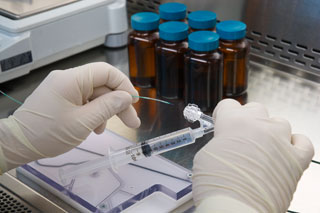Testing Locations
- Salt Lake City, UT, USA
- Itasca, IL, USA
- Leuven, Belgium
- Petit-Rechain, Belgium
- Ratigny, France
Learn more about our locations and their certifications.
Study Outline
Automatic HIAC Royco method USP <788> (Method 1)
This Particulate Analysis procedure is taken from the United States Pharmacopeia Method <788>, which gives criteria for injectable solutions.
Solutions are mixed by inverting 20 times, allowing the solutions to degas, then analyzing on a liquid particle counter.
Devices are extracted with an appropriate solvent such as low particulate water by flushing, rinsing, orbital shaking, or simulated use testing. The extracts are degassed and tested on the liquid particle counter.
The particle counter withdraws not less than three aliquots, of not less than 5 mL. The liquid particle counter is capable of calculating the average cumulative counts, average differential counts, average cumulative counts per mL, and average differential counts per mL. Per the USP, it will automatically omit the data from the first run.
The size ranges used for USP testing are ≥10 and ≥25 μm. The liquid particle counter is capable of sizing and counting particles ranging from 2 μm to 100 μm. Sponsors may select any particle size range(s) between 2 to 100 μm appropriate for the test sample.
Light Microscopy method USP <788> (Method 2)
Some injections cannot be tested by light obscuration (Method 1) for various reasons. Examples of such products are emulsions, colloids, liposomal preparations, and products that produce air or gas bubbles when drawn into the sensor, such as bicarbonate-buffered formulations. For these products, microscopic testing may be used exclusively.
The procedure is taken from the United States Pharmacopeia Method <788>, which gives criteria for injectable solutions.
Devices are extracted with an appropriate solvent such as low particulate water by flushing, rinsing, orbital shaking, or simulated use testing. Solutions, whether device effluent or liquid sample, are filtered through a pre-cleaned, 1.0 µm or finer pore size, membrane filter.
After filtration, the membrane filters are placed into petri slides and dried. Microscope slides are analyzed under a microscope, using a calibrated graticule, at 100X magnification. Using oblique illumination at an angle of 10˚ to 20˚, the particles on the surface of the membrane are sized and counted using the graticule micrometer.
The size ranges used for USP testing are ≥10 and ≥25 μm. Additional sizes can be enumerated ranging from 10 µm to 1,000 µm. Sponsors may select any particle size range(s) between 10 to 1,000 μm as appropriate for the test sample.
In addition to sizing and counting particulate matter, photos of particle matter can be provided upon sponsor request.
EN 45502 and ISO 14708
The test is an automatic particulate analysis (light obscuration) which is specific to active implantable medical devices such as pacemakers, leads, and other accessories that may be partially or completely implanted. Multiple variations of these standards might be selected for testing and should be evaluated prior to submission. The device and accessories are immersed in physiological saline or low particulate water (LPW) using a surface to volume ratio. The device is then incubated on an orbital shaker for 8-18 hours or 8-24 hours. The particles are enumerated at either ≥5µm and ≥25µm, or ≥10µm and ≥25µm size ranges.
NOTE: Surface area or volume of the device and accessories are required for calculations.
USP <789>
The test is an automatic or microscopic particulate analysis for ophthalmic solutions. This standard is similar to USP <788> but includes specifications and instructions specific to solutions that have ophthalmic applications. The ≥50 μm particulate size is evaluated in addition to ≥10 µm and ≥25 μm sizes. USP <771> should be viewed prior to submitting samples for USP <789> testing.
ISO 8536-4 and ISO 1135-4
The test is a microscopic particulate analysis which is specific to gravity fed infusion devices and accessories used in gravity fed infusion. The specification is provided as an ‘N’ value (also known as the contamination index) which is calculated using enumerated and sized particles ranging from 25-50 µm, 51-100 µm, and ˃100 μm.
ANSI/AAMI AT6
This test is a microscopic particulate analysis for autologous transfusion devices. The device is filled to volume with low particulate water. The water is then drained, collected, and filtered through a membrane filter, followed by a microscopic particulate enumeration of ≥10 µm and ≥25 μm particle sizes as well as fibers.
ANSI/AAMI TIR42 and FDA Guidance Document for Certain Percutaneous Transluminal Coronary Angioplasty Catheters (PTCA)
Nelson Labs also has a great deal of experience in the new regulatory guidance documents regarding particulate matter testing of vascular medical devices. Services include assistance in developing custom test procedures to simulate the use of the device, procedure validation, full service extraction, exhaustive rinse and analysis, and assistance in composition analysis of particulate matter. Model variations are an additional test service that is recommended when anatomical models are to be used for testing.
Sample size/recommended replicates: USP requirements state that “the number of test specimens must be adequate to provide statistically sound assessment of whether a batch or other large group or units represented by the test specimens meets or exceeds the limits. For small volume injections where the individual unit volume is 25 mL or more, fewer than 10 units may be tested, based on the definition of an appropriate sampling plan.”
For large volume injections, individual units are tested.
If you have additional questions about Particulate Analysis test services, or would like to consult with the experts at Nelson Labs, just send us a request or call us at +1 (801) 290-7500.



